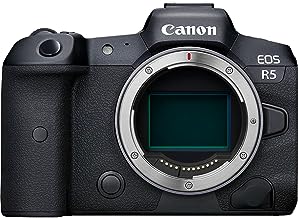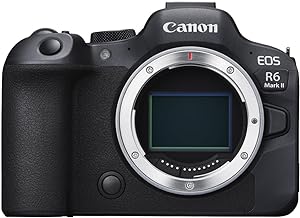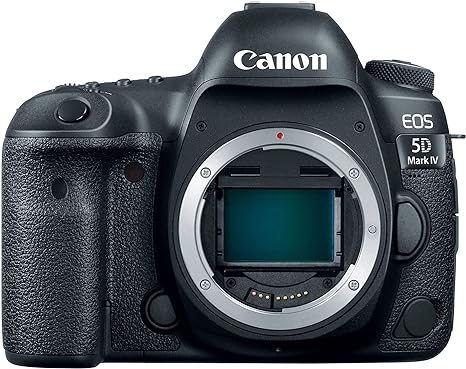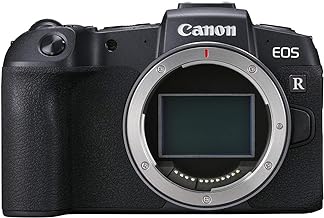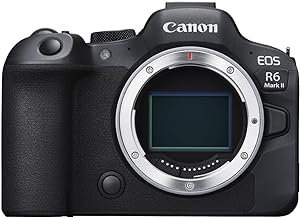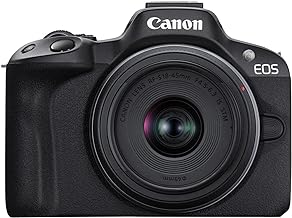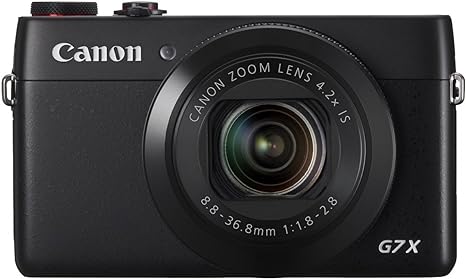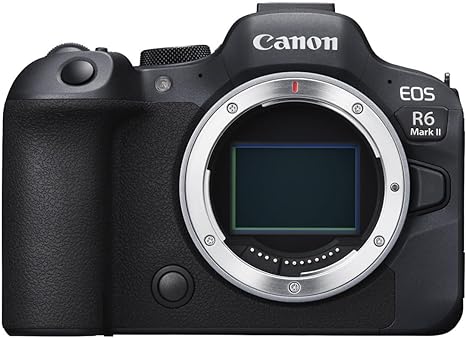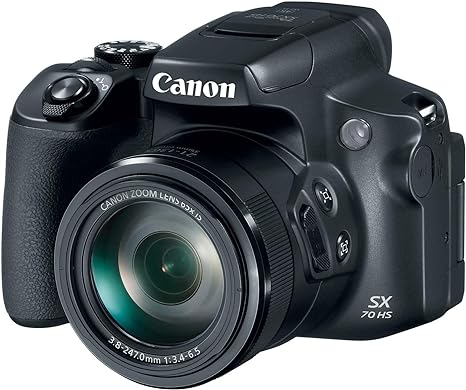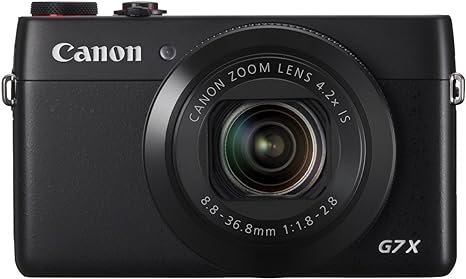Best Canon Camera Review : A Comprehensive Review
Canon Camera has long been a leader in the photography world, offering a wide range of cameras suitable for all types of photographers, from beginners to professionals.
- High-Resolution Imaging: The latest Canon camera features a sensor that captures incredibly detailed images.
- Cutting-Edge Autofocus: Advanced autofocus technology, including Dual Pixel CMOS AF and eye-detection AF, ensures swift and precise focusing.
- 4K Video Capabilities: Capable of recording 4K video, it offers superb video quality with multiple frame rate options.
- Easy-to-Use Interface: The camera has a user-friendly touchscreen and straightforward menus, suitable for all skill levels.
- Built-In Connectivity: With integrated Wi-Fi and Bluetooth, you can easily share photos and control the camera remotely using compatible devices.
- Wide Lens Compatibility: Compatible with Canon EF, EF-S, and RF lenses, as well as various third-party lenses, for versatile shooting options.
History of Canon Camera
- Founded in 1937: Canon has been a pioneer in the camera industry for over 80 years, starting with the release of Japan’s first 35mm focal-plane-shutter camera.
- First SLR Camera in 1959: The Canon Flex marked Canon’s entry into the SLR market, establishing a foundation for future innovations.
- EOS System in 1987: Introduction of the EOS system revolutionized autofocus technology and electronic integration in cameras.
- Digital Transition: In the early 2000s, Canon transitioned to digital with the launch of the EOS D30, paving the way for modern digital photography.
Benefits of Canon Camera
- Innovative Technology: Canon cameras are known for their cutting-edge technology, including advanced autofocus systems and superior image processing.
- Versatility: With a wide range of models from entry-level to professional, Canon caters to all types of photographers.
- Durability: Canon cameras are built to last, often featuring robust, weather-sealed bodies ideal for various shooting conditions.
- Image Quality: Renowned for their excellent image quality, Canon cameras deliver sharp, vibrant photos with exceptional detail.
- Extensive Lens Selection: Canon offers a vast array of lenses, providing photographers with the tools they need for any creative vision.
- User-Friendly Interface: Canon cameras are designed with intuitive controls and menus, making them accessible to both beginners and professionals.
Top Canon Camera Review of 2024
Canon has long been a leader in the photography world, offering a wide range of cameras suitable for all types of photographers, from beginners to professionals. In this article, we will review the top 20 Canon cameras, highlighting their features, pros, and cons to help you make an informed decision.
Canon EOS R5 Camera Review
The Canon EOS R5 is a powerhouse in the world of mirrorless cameras. With its 45MP full-frame sensor, 8K video recording capabilities, and advanced autofocus system, it’s a top choice for professional photographers and videographers.
Canon EOS R5 Camera Pros and Cons
Pros
- High-Resolution Sensor : The Canon EOS R5 boasts a 45-megapixel full-frame CMOS sensor, which delivers stunning image quality with exceptional detail and dynamic range.
- Advanced Autofocus System : Equipped with Canon’s Dual Pixel CMOS AF II, the EOS R5 features 1,053 automatically selectable AF points, providing fast and accurate autofocus, especially beneficial for capturing moving subjects.
- In-Body Image Stabilization (IBIS) : The camera includes a 5-axis in-body image stabilization system, which works in conjunction with Canon RF lenses to deliver up to 8 stops of shake correction, significantly enhancing handheld shooting capabilities.
- Impressive Video Capabilities : Capable of recording 8K video at up to 30fps and 4K at up to 120fps, the EOS R5 is a powerful tool for videographers, offering high resolution and frame rate options for versatile filming.
- Excellent Build Quality : The EOS R5 features a robust magnesium alloy body with weather sealing, making it durable and reliable in various shooting conditions.
- High-Speed Continuous Shooting : With a continuous shooting speed of up to 20 frames per second (fps) with the electronic shutter and 12 fps with the mechanical shutter, the R5 is ideal for sports, wildlife, and action photography.
- Advanced Connectivity : The camera includes built-in Wi-Fi and Bluetooth, facilitating easy image transfer and remote control via the Canon Camera Connect app.
- User-Friendly Interface : The intuitive menu system, combined with a high-resolution electronic viewfinder (EVF) and a fully articulating touchscreen, ensures a seamless and enjoyable user experience.
- Dual Card Slots : The EOS R5 is equipped with dual card slots (one CFexpress and one SD UHS-II), providing flexibility, faster write speeds, and additional storage options.
Cons
- High Cost : The Canon EOS R5 is a premium camera with a price tag to match, making it a significant investment, especially for hobbyists and amateur photographers.
- Overheating Issues in 8K/4K Video Recording : Extended 8K and 4K video recording can lead to overheating, resulting in limited continuous recording times and potential interruptions during shoots.
- Large File Sizes : The high-resolution images and 8K video files can quickly consume storage space, necessitating high-capacity memory cards and robust storage solutions.
- Battery Life : While the battery life is decent, the power consumption of the high-resolution sensor and advanced features can drain the battery relatively quickly, requiring extra batteries for extended shooting sessions.
- Complexity for Beginners : The plethora of features and settings may be overwhelming for beginners, requiring a learning curve to fully utilize the camera’s capabilities.
- Limited RF Lens Selection : Although the RF lens lineup is growing, it is still not as extensive as Canon’s EF lens range, potentially limiting lens options for specific needs.
- Expensive Accessories : The need for CFexpress cards, extra batteries, and potentially new RF lenses can add to the overall cost of owning and operating the EOS R5.
- Firmware Updates Needed : Some initial issues and bugs have required firmware updates, necessitating regular maintenance to ensure optimal performance.
These pros and cons provide a comprehensive view of the Canon EOS R5, helping potential buyers weigh its strengths and weaknesses against their specific needs and preferences.
Canon EOS R6 Camera Review
The Canon EOS R6 offers excellent performance for both photography and videography. It features a 20MP full-frame sensor, 4K video recording, and impressive image stabilization.
Canon EOS R6 Camera Pros and Cons
Pros
- Impressive Image Quality : The Canon EOS R6 features a 20.1 MP full-frame CMOS sensor that delivers outstanding image quality. The sensor captures high-resolution images with excellent detail, dynamic range, and low noise, even at higher ISO settings. This makes it an excellent choice for various photography genres, including landscapes, portraits, and low-light scenarios.
- High-Speed Performance : The R6 boasts a powerful DIGIC X image processor, enabling high-speed performance. It offers up to 12 frames per second (fps) with the mechanical shutter and up to 20 fps with the electronic shutter. This is particularly beneficial for action, sports, and wildlife photography, where capturing fast-moving subjects is crucial.
- Advanced Autofocus System : One of the standout features of the EOS R6 is its Dual Pixel CMOS AF II system. With 1,053 automatically selectable AF zones, it provides fast, accurate, and reliable autofocus performance. Eye detection and tracking for both humans and animals ensure sharp focus on the subject, enhancing portrait and wildlife photography.
- In-Body Image Stabilization (IBIS) : The camera includes a 5-axis in-body image stabilization system that works with both RF and EF lenses (with an adapter). This feature significantly reduces camera shake, allowing for handheld shooting at slower shutter speeds and providing sharper images and smoother videos, even in low-light conditions.
- 4K Video Recording : The EOS R6 supports 4K UHD video recording at up to 60p, offering high-quality video output. It also provides Full HD 1080p recording at up to 120p for slow-motion effects. The combination of high-resolution video, advanced autofocus, and image stabilization makes it a versatile tool for videographers.
- Ergonomic Design : Canon has designed the R6 with a comfortable and ergonomic grip, ensuring ease of use during extended shooting sessions. The camera body is also weather-sealed, providing durability and protection against dust and moisture, making it suitable for outdoor and challenging shooting environments.
Cons
- 20.1 MP Resolution : While the 20.1 MP sensor provides excellent image quality, some photographers may find the resolution limiting, especially for large prints or extensive cropping. Competitors in the same price range often offer higher resolution sensors, which can be a deciding factor for certain users.
- Overheating Issues : The R6 has been reported to experience overheating issues during extended video recording sessions, particularly in 4K mode. This can limit continuous recording time and may require frequent breaks to allow the camera to cool down, which can be a drawback for videographers working on longer projects.
- Battery Life : The battery life of the EOS R6 is relatively short compared to some other full-frame mirrorless cameras. It is rated for approximately 380 shots per charge using the EVF and about 510 shots with the LCD. This can be limiting for long shoots, and carrying extra batteries is often necessary.
- Rolling Shutter Effect : When using the electronic shutter, especially in fast-moving scenes or during panning shots, the R6 can exhibit noticeable rolling shutter effect. This distortion can affect the quality of images and videos, making it less suitable for certain types of high-speed photography and videography.
- Limited Lens Selection for RF Mount : Although Canon is rapidly expanding its RF lens lineup, the selection is still more limited compared to the extensive range of EF lenses available for DSLR cameras. Adapters can be used to mount EF lenses, but this may not be ideal for all users, particularly those looking for native RF lens options.
The Canon EOS R6 is a powerful and versatile camera that offers a range of advanced features suitable for both photographers and videographers. Its impressive image quality, high-speed performance, and advanced autofocus system make it a strong contender in the full-frame mirrorless market.
Canon EOS 5D Mark IV Camera Review
The Canon EOS 5D Mark IV is a versatile DSLR that delivers stunning image quality with its 30.4MP full-frame sensor. It’s known for its robust build and reliable performance in various shooting conditions.
Canon EOS 5D Mark IV Camera Pros and Cons
Pros
- High Image Quality : The 30.4 MP full-frame CMOS sensor delivers high-resolution images with excellent detail and dynamic range, making it ideal for professional photography.
- 4K Video Recording : Capable of recording 4K video at 30fps, providing exceptional video quality. It also supports Full HD at 60fps and HD at 120fps, offering versatility for videographers.
- Dual Pixel CMOS AF : This autofocus system ensures fast and accurate focusing during live view and video recording, enhancing overall shooting efficiency.
- ISO Range : Wide native ISO range of 100-32,000 (expandable to 50-102,400), allowing for excellent performance in various lighting conditions, from bright sunlight to low-light environments.
- DIGIC 6+ Image Processor : The powerful processor enables fast image processing, reduces noise, and supports continuous shooting at up to 7 frames per second, which is beneficial for action and sports photography.
- Built-in Wi-Fi and GPS : Offers wireless connectivity for easy sharing and transferring of photos and videos. The built-in GPS allows geotagging of images, useful for travel photographers.
- Robust Build Quality : Constructed with a magnesium alloy body, the camera is both durable and weather-sealed, providing protection against dust and moisture for shooting in challenging conditions.
- Touchscreen LCD : The 3.2-inch touchscreen provides intuitive navigation and control, making it easier to change settings, review images, and focus during live view shooting.
- Dual Memory Card Slots : Supports CF and SD cards, offering flexibility and increased storage capacity, as well as redundancy for critical shoots.
- Advanced Metering System : The 61-point AF system with 41 cross-type sensors and an advanced metering system ensures precise exposure and focus accuracy, enhancing the quality of the final images.
Cons
- 4K Video Crop Factor : When recording 4K video, there is a 1.74x crop factor, which limits the field of view and may require wider lenses to achieve desired framing.
- Large File Sizes : High-resolution images and 4K videos produce large file sizes, requiring substantial storage space and potentially slower processing times during post-production.
- No Built-in Flash : Lacks a built-in flash, necessitating the use of external flash units for low-light situations, which can be inconvenient for some users.
- Expensive : As a high-end professional camera, it comes with a significant price tag, which may not be justifiable for amateur photographers or those on a budget.
- Weight and Size : The camera is relatively heavy and bulky, making it less portable and potentially cumbersome for extended handheld shooting sessions.
- Limited Articulating Screen : The touchscreen is fixed and does not fully articulate, which can be a drawback for vloggers and photographers who require versatile shooting angles.
- Complex Menus : The extensive features and customization options can result in complex menus, which may have a steep learning curve for new users or those unfamiliar with Canon’s interface.
- Battery Life : While sufficient for most shooting situations, the battery life could be better, especially when compared to some mirrorless cameras that offer longer endurance.
- No IBIS : The camera lacks in-body image stabilization (IBIS), relying instead on lens-based stabilization, which might be a disadvantage for handheld shooting in low light or at slower shutter speeds.
Canon EOS RP Camera Review
The Canon EOS RP is an affordable entry into the world of full-frame mirrorless cameras. It features a 26.2MP sensor and offers a compact and lightweight design, making it a great choice for travel photography.
Canon EOS RP Camera Pros and Cons
Pros
- Image Quality: The 26MP full-frame sensor delivers excellent image quality, especially in good lighting conditions. You can expect sharp photos with vibrant colors and good dynamic range.
- Compact and Lightweight: Compared to other full-frame cameras, the EOS RP is remarkably compact and lightweight. This makes it ideal for travel or photographers who prefer a more manageable camera body.
- Excellent Autofocus: Canon’s Dual Pixel CMOS AF system provides fast and accurate autofocus, even in low-light situations. This is particularly beneficial for capturing fleeting moments or fast-moving subjects.
- Fully Articulating Touchscreen: The high-resolution touchscreen allows for intuitive control and easy menu navigation. The tilting functionality is perfect for composing shots from different angles.
- Decent Battery Life: The battery life is sufficient for a day’s worth of shooting, especially for casual users. However, heavy use or video recording might require a spare battery.
Cons
- Limited Video Capabilities: While the EOS RP can shoot 4K video, it has some limitations. Autofocus performance can be inconsistent in video mode, and there’s a crop applied when shooting in 4K. For videographers, other options might be better suited.
- Slower Burst Shooting: The burst shooting rate is not the fastest compared to some competitors. This could be a drawback for photographers who specialize in action or sports photography.
- Limited Lens Selection (at launch): When the EOS RP was first released, the RF lens mount system for Canon mirrorless cameras was still new. This meant a smaller selection of native lenses compared to more established systems. However, the RF lens lineup has expanded significantly since then.
- No In-Body Image Stabilization (IBIS): Unlike some competitors, the EOS RP lacks in-body image stabilization. This can be a disadvantage for handheld shooting in low-light conditions. However, some RF lenses offer lens-based image stabilization.
The Canon EOS RP is a compelling choice for photographers seeking a well-rounded and affordable entry point into full-frame mirrorless photography. It excels in image quality, portability, and ease of use.
Canon EOS 6D Mark II Camera Review
The Canon EOS 6D Mark II is a popular choice for enthusiasts looking to upgrade to a full-frame DSLR. It boasts a 26.2MP sensor, excellent low-light performance, and built-in GPS and Wi-Fi.
Canon EOS 6D Mark II Camera Pros and Cons
Pros:
- Excellent Image Quality: The 26.2MP full-frame CMOS sensor delivers sharp, detailed images with good low-light performance.
- Improved Autofocus: The 45-point all-cross-type phase-detect autofocus system offers fast and accurate focusing, especially in live view mode thanks to Dual Pixel CMOS AF technology.
- Weather Sealing: The magnesium alloy body is weather-sealed, making it suitable for shooting in challenging conditions.
- Vari-angle LCD Screen: The fully articulating touchscreen LCD screen allows for comfortable shooting from various angles and simplifies live view monitoring.
- Long Battery Life: With a CIPA rating of 1200 shots, the battery life is impressive for a full-frame DSLR, allowing you to shoot for extended periods.
- Canon Color Science: Many photographers praise Canon’s color science for its natural and pleasing tones.
Cons:
- Limited Dynamic Range: Compared to newer cameras, the dynamic range of the 6D Mark II is somewhat limited, meaning it may struggle to capture detail in both highlights and shadows in high-contrast scenes.
- No 4K Video: While it offers Full HD video recording, the camera lacks the capability to shoot in 4K resolution, which has become a standard feature in newer models.
- Limited Video Features: Autofocus performance in video mode is not as smooth as with stills, and there’s a lack of advanced video features like microphone input or headphone jack.
- Bulkier Than Mirrorless Cameras: Full-frame DSLRs like the 6D Mark II are generally larger and heavier than mirrorless cameras with similar capabilities.
- No In-Body Image Stabilization: The camera lacks in-body image stabilization, which can be a disadvantage for handheld shooting at slower shutter speeds.
The Canon EOS 6D Mark II remains a capable full-frame camera, especially for photographers who prioritize image quality and affordability. However, if you need advanced video features, superior dynamic range, or a more compact design, newer mirrorless cameras might be a better fit.
Canon EOS 90D Camera Review
The Canon EOS 90D is a powerful DSLR with a 32.5MP APS-C sensor, making it a great option for wildlife and sports photography. It also features 4K video recording and a fast autofocus system.
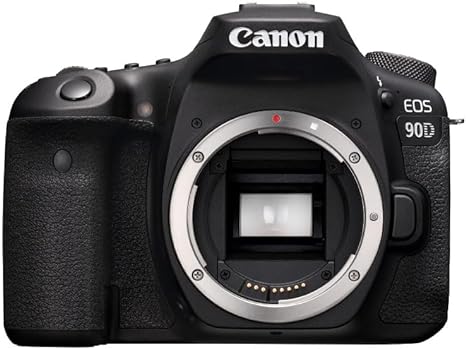
Canon EOS 90D Camera Pros and Cons
Pros:
- Superb Image Quality: The 32.5MP APS-C CMOS sensor delivers crisp, detailed images, especially at lower ISOs. It performs well in low light situations as well.
- Fast Autofocus: The 45-point all-cross-type phase-detect autofocus system is speedy and accurate, both through the viewfinder and in Live View mode. This makes it ideal for capturing fast-moving subjects like athletes or wildlife.
- Excellent Burst Shooting: The 10fps burst shooting mode allows you to capture fleeting moments with incredible detail.
- 4K Video Recording: The 90D offers 4K video recording at 30fps, although with a slight crop to the sensor. It also boasts Full HD recording at up to 120fps for slow-motion effects.
- Durable Build Quality: The weather-sealed magnesium alloy body is built to withstand tough conditions, making it a good choice for outdoor photographers.
- Optical Viewfinder: Photographers who prefer a traditional shooting experience will appreciate the bright and clear optical viewfinder with 100% coverage.
- Vari-angle Touchscreen: The fully articulating touchscreen LCD is perfect for composing shots from various angles and offers intuitive touch controls for navigating menus and selecting focus points.
Cons:
- Bulkier and Heavier: Compared to newer mirrorless cameras, the 90D is heavier and bulkier. This can be a drawback for photographers who prioritize portability.
- Menu System: Some users find the menu system to be a bit cluttered and complex, especially for beginners.
- Limited Video Features: While the 90D offers decent video capabilities, it lacks advanced features like Log recording and unlimited recording times, which might be dealbreakers for serious videographers.
- High-Resolution Sensor Trade-off: The high megapixel count can lead to increased noise at higher ISOs. Additionally, the low-pass filter might slightly reduce image sharpness.
- Limited Battery Life: Battery life is not the strongest on the 90D, so you might need to invest in extra batteries for extended shooting sessions.
- Maturing Technology: Released in 2019, the 90D might not offer the latest and greatest technology compared to newer cameras.
Canon EOS M50 Mark II Camera Review
The Canon EOS M50 Mark II is a compact mirrorless camera with a 24.1MP APS-C sensor. It’s a popular choice for vloggers and content creators due to its versatile video features and compact size.
Canon EOS M50 Mark II Camera Pros and Cons
Pros:
- Image Quality: The M50 Mark II boasts a 24.1MP APS-C CMOS sensor, similar to higher-end DSLRs. This translates to excellent image quality, especially in low-light situations with minimal noise.
- Autofocus: The autofocus system has seen a significant upgrade with faster and more accurate subject tracking, including impressive eye-detection autofocus for both stills and videos.
- Video Capabilities: The camera shoots 4K video at up to 25fps, offering good quality for casual vlogging or filmmaking. It also features a mic port and vertical video shooting mode, catering to the growing trend of mobile content creation.
- Compact and Portable: Mirrorless cameras are known for their lighter weight and smaller size compared to DSLRs. The M50 Mark II is perfect for travel or situations where portability is key.
- Fully Articulating Touchscreen: The high-resolution touchscreen allows for easy framing and intuitive control, making it ideal for selfies, vlogging, and navigating menus.
Cons:
- Battery Life: The battery life is somewhat underwhelming, with CIPA ratings around 305 shots per charge. This may be a concern for heavy users who shoot extended periods without access to a power source.
- Limited Lens Selection: While Canon’s EOS M system has grown, it still offers a smaller lens selection compared to more established mirrorless systems like Sony or Fuji.
- Limited Physical Controls: The M50 Mark II prioritizes a sleek design, sacrificing some physical dials and buttons found on higher-end cameras. This can slow down adjustments for experienced photographers who prefer tactile controls.
- No Built-in Viewfinder: There’s no electronic viewfinder (EVF) on the M50 Mark II. This can be a disadvantage in bright conditions or for photographers who prefer composing shots through a viewfinder.
- Price: The M50 Mark II falls in a competitive price range, but some might find it slightly expensive considering the limitations mentioned above.
Canon G7 X Mark III Camera Review
The Canon PowerShot G7 X Mark III is a compact camera ideal for vloggers and travel photographers. It features a 20.1MP 1-inch sensor, 4K video recording, and a flip-up touchscreen.
Canon Camera G7 X Mark III Pros and Cons
Pros:
- Excellent Image Quality: The G7 X Mark III boasts a large 1-inch sensor, capturing sharp images with good low-light performance and minimal noise.
- 4K Video Recording: This camera excels in videography, offering 4K resolution at 30 fps and a microphone input for high-quality audio capture.
- Fast Autofocus and Burst Shooting: The DIGIC 8 image processor enables speedy autofocus and continuous shooting up to 30fps (RAW burst), ideal for capturing fast-paced action.
- Compact and Portable: This camera’s pocketable size makes it a perfect travel companion or everyday carry.
- Tilting Touchscreen Display: The intuitive touchscreen allows for easy navigation, focusing, and menu control.
Cons:
- Limited Zoom Lens: The G7 X Mark III features a 4.2x optical zoom lens, which might be limiting for photographers who prefer more telephoto reach. Consider the Canon G5 X Mark II for a 5x zoom if needed.
- No Viewfinder: The G7 X Mark III lacks an electronic viewfinder (EVF), which can be a disadvantage in bright outdoor conditions or for photographers who prefer composing shots through an EVF.
- Average Battery Life: Battery life is decent but not exceptional, so carrying a spare or external charger for extended shoots is recommended.
- Limited Manual Controls: While offering some manual controls, enthusiasts might find the G7 X Mark III lacking in advanced shooting modes and customization options compared to larger interchangeable lens cameras (ILCs).
- Price Point: The G7 X Mark III falls in a mid-range price bracket for compact cameras. Consider your budget and needs before purchasing.
Canon EOS-1D X Mark III Camera Review
The Canon EOS-1D X Mark III is a top-tier DSLR designed for professional sports and wildlife photographers. It features a 20.1MP full-frame sensor, 5.5K RAW video recording, and an incredibly fast burst rate.
Canon EOS-1D X Mark III Camera Pros and Cons
Pros:
- Blazing Fast Performance: With a shooting speed of up to 20 frames per second with full autofocus and autoexposure, the 1D X Mark III excels in capturing fast-action moments like sports or wildlife.
- Superior Autofocus: Featuring a highly advanced 191-point autofocus system with exceptional subject tracking, this camera ensures sharp focus even on moving targets.
- Superb Image Quality: The 20.1-megapixel full-frame CMOS sensor delivers stunning image detail, dynamic range, and low-light performance.
- Durable Build: The weather-sealed magnesium alloy body is built to withstand harsh conditions and professional use.
- Extensive Customization: Professional photographers can tailor the camera’s controls and settings to their specific shooting style.
- 4K Video Recording: Capture high-resolution video with smooth 60fps frame rates, ideal for professional videography projects.
Cons:
- Bulk and Weight: Being a professional-grade camera, the 1D X Mark III is significantly heavier and larger than most consumer DSLRs, making it less ideal for casual use.
- High Price Tag: This camera comes at a premium price, making it an investment for serious photographers.
- Steeper Learning Curve: With its extensive features and customization options, the 1D X Mark III has a steeper learning curve compared to beginner-friendly cameras.
- Limited Battery Life: While the battery offers decent life for professional use, it may not be sufficient for extended shoots without a spare.
- Lower Resolution Compared to Newer Models: With newer mirrorless cameras boasting higher megapixel counts, the 1D X Mark III’s 20.1 MP sensor may not be ideal for photographers seeking the absolute highest resolution.
Canon EOS R6 Mark II Camera Review
The Canon EOS R6 Mark II is a high-performance mirrorless camera with a 32.5MP APS-C sensor. It’s compact, offers 4K video recording, and has an impressive burst rate.
Canon EOS R6 Mark II Camera Pros and Cons
Pros:
- Superb Image Quality: The 24.2MP full-frame sensor delivers excellent image detail, dynamic range, and low-light performance.
- Blazing-Fast Performance: With a 12fps mechanical shutter and a staggering 40fps electronic shutter, you’ll never miss a fleeting moment.
- Enhanced Autofocus: The upgraded Dual Pixel CMOS AF system boasts subject recognition and tracking for animals, people, and vehicles.
- Impressive Video Specs: The R6 Mark II shoots stunning 4K UHD video at 60fps with oversampling from 6K for exceptional detail. It even allows external 6K ProRes RAW recording for maximum flexibility in post-production.
- Improved In-Body Image Stabilization (IBIS): The 5-axis IBIS system effectively combats camera shake for sharper photos and smoother videos, especially at slower shutter speeds.
- High-Resolution Viewfinder: The 0.39-inch electronic viewfinder offers a bright, crisp image with a high refresh rate for a seamless shooting experience.
- Articulating Touchscreen Display: The fully articulating touchscreen allows for comfortable shooting from various angles and intuitive control over settings.
Cons:
- Limited Battery Life: While improved compared to the R6, battery life can still be a concern for extended shoots. Consider investing in extra batteries.
- Micro-HDMI Port: The camera comes with a micro-HDMI port, limiting connectivity options for external monitors compared to a full-sized HDMI port.
- No In-Body Sensor Stabilization (IBIS) for Video: While IBIS helps with photos, it doesn’t function for video recording. You’ll need to rely on lens stabilization or external gimbals for smooth video footage.
- Price Point: The R6 Mark II sits at a premium price point compared to some competitors.
- No Built-in GPS: If geotagging your photos is important, you’ll need to pair the camera with a smartphone via Bluetooth.
- Heating During Video Recording: Extended video recording, particularly in high-resolution settings, can cause the camera to overheat. Consider recording intervals or external cooling solutions.
Canon SX740 HS Camera Review
The Canon PowerShot SX740 HS is a compact travel zoom camera with a 20.3MP sensor and a 40x optical zoom lens. It’s perfect for travelers looking for a versatile and portable camera.
Canon SX740 HS Camera Pros and Cons
Pros:
- Unmatched Zoom Power: The SX740 HS shines with its incredible 40x optical zoom, offering exceptional telephoto capabilities. This is ideal for capturing wildlife, sporting events, or zooming in on architectural details.
- Pocketable Convenience: Despite its powerful zoom, the SX740 HS remains surprisingly compact and lightweight. It’s easy to carry around on day trips or vacations, making it a great travel companion.
- Fast Continuous Shooting: With a shooting speed of 10 frames per second, the SX740 HS can capture action sequences with decent results, suitable for capturing kids or pets in motion.
- 4K Video Recording: The camera offers 4K video recording, allowing you to capture high-resolution videos for special occasions or vlogging (although some limitations apply, see cons).
- Easy to Use: The SX740 HS features a user-friendly interface with automatic shooting modes, making it a good choice for beginners or casual photographers.
Cons:
- Image Quality: While the SX740 HS produces decent images in good lighting, image quality can suffer in low-light conditions due to a smaller sensor size. Images might appear soft and noise can become an issue at higher ISO settings.
- Limited Creative Control: The SX740 HS lacks some features found in more advanced cameras, such as a raw shooting mode and a viewfinder. This limits the level of creative control photographers have over their images.
- No Touchscreen: The LCD screen is bright and tilts for selfies, but it’s not a touchscreen. This can make navigating menus and selecting focus points less intuitive compared to touchscreen cameras.
- 4K Video Caveats: While the camera offers 4K recording, it comes with a significant crop, meaning you lose a substantial portion of the wide-angle capabilities. Additionally, there’s no external microphone jack for improved audio quality.
- Battery Life: Battery life is average, so you might want to consider carrying a spare for extended shooting sessions.
Canon EOS 77D Camera Review
The Canon EOS 77D is a versatile DSLR with a 24.2MP APS-C sensor. It offers a good balance of performance and features, making it suitable for a wide range of photography needs.
Canon EOS 77D Camera pros and Cons
Pros:
- Excellent Image Quality: The 24.2MP APS-C CMOS sensor delivers sharp, detailed images with good low-light performance thanks to its DIGIC 7 processor.
- Fast and Accurate Autofocus: The 45-point phase-detection autofocus system is quick and reliable, especially beneficial for capturing action shots or fast-moving subjects. It also excels in Live View mode, making it a good choice for video shooters.
- Improved Battery Life: Compared to its predecessor, the 77D boasts a significant improvement in battery life, allowing you to capture up to 600 shots on a single charge.
- Vari-Angle Touchscreen: The 3-inch touchscreen LCD with a swiveling mechanism allows for comfortable shooting from various angles and easy menu navigation through intuitive touch controls.
- Wide Lens Selection: Canon’s extensive EF and EF-S lens mount compatibility opens doors to a vast array of high-quality lenses for various photography styles.
- Wi-Fi and NFC Connectivity: Built-in Wi-Fi and NFC allow for easy image sharing and remote camera control through your smartphone.
Cons:
- No 4K Video: While the 77D offers Full HD video recording at up to 60fps, it lacks the capability for high-resolution 4K video capture, which might be a dealbreaker for videography enthusiasts.
- Limited Viewfinder: The optical viewfinder offers only 95% coverage and uses a pentamirror design, which can be less accurate in color representation compared to a pentaprism viewfinder found in higher-end models.
- Plastic Build Quality: While the build feels solid, it’s primarily constructed of plastic, which might not feel as premium compared to some metal-bodied cameras.
- Not Weather-Sealed: The camera body itself isn’t weather-sealed, making it less ideal for shooting in harsh weather conditions or dusty environments.
- Limited Continuous Shooting Speed: The 6fps continuous shooting speed might be limiting for capturing fast-paced action sequences compared to newer models with faster burst rates.
- Price: The 77D, while not the most expensive option, might face competition from newer mirrorless cameras offering similar features and potentially more compact designs.
Canon EOS Rebel SL3 Camera Review
The Canon EOS Rebel SL3 is a compact and lightweight DSLR with a 24.1MP APS-C sensor. It’s great for beginners and offers 4K video recording, a vari-angle touchscreen, and excellent battery life.
Canon EOS Rebel SL3 Camera Pros and cons
Pros:
- Compact and Lightweight: The SL3 boasts the title of the world’s lightest DSLR, making it incredibly portable and ideal for travel or everyday use. Its comfortable grip allows for easy handling, even for smaller hands.
- Excellent Image Quality: Despite its compact size, the SL3 packs a punch with its 24.1MP APS-C CMOS sensor. This delivers sharp, high-resolution images in good lighting conditions.
- Vari-Angle Touchscreen: The fully articulating touchscreen display allows for creative shooting angles and intuitive control over settings. Whether you’re capturing low-angle macro shots or overhead crowd scenes, the screen adjusts for comfortable viewing.
- 4K Video Recording: While not the most advanced video option on the market, the SL3 offers 4K video recording at 25fps. This allows for capturing basic high-resolution videos for social media or personal projects.
- Easy to Use: The SL3 features a user-friendly interface with clear menus and helpful on-screen guides. This makes it ideal for beginners who want to learn the fundamentals of photography without feeling overwhelmed.
Cons:
- Limited Autofocus: The SL3 has only 9 autofocus points in the viewfinder, which can be limiting for fast-action photography or capturing moving subjects.
- Battery Life: Compared to mirrorless cameras, the SL3’s battery life is considered average. If you plan on extended shooting sessions, consider investing in a spare battery.
- Limited Third-Party Flash Support: The hot shoe on the SL3 doesn’t work with all third-party flashes, restricting your options for off-camera lighting setups.
- Bulkier Than Mirrorless Cameras: While compact for a DSLR, the SL3 is still larger and heavier than some mirrorless cameras with similar capabilities.
- Limited Low-Light Performance: While the image quality is good in well-lit environments, the SL3 can struggle with noise in low-light situations. This might be a concern for photographers who shoot indoors or at night frequentl
Canon G7 X Mark II Camera Review
The Canon PowerShot G7 X Mark II is a premium compact camera with a 20.1MP 1-inch sensor. It features a pop-up viewfinder, fast autofocus, and 4K video recording.
Canon G7 X Mark II Camera Pros and cons
Pros:
- Image Quality: The G7 X Mark II boasts a larger-than-average 1-inch sensor for a compact camera. This translates to better low-light performance and sharper images compared to smartphone cameras.
- Compact Size: This camera is incredibly pocketable, making it ideal for travel or everyday use where you don’t want to lug around heavy equipment.
- Fast Autofocus: Improved autofocus compared to the previous model makes capturing fleeting moments easier, especially for casual photographers.
- Tilting Touchscreen: The tilting touchscreen LCD allows for more creative shooting angles and intuitive control over settings.
- Wi-Fi and NFC Connectivity: Easily share your photos and videos wirelessly to your smartphone or tablet for editing and sharing.
Cons:
- Limited Zoom: The 4.2x optical zoom lens might feel restrictive for photographers who want more telephoto capability.
- No 4K Video: While the camera can shoot Full HD video, it lacks the capability for higher resolution 4K video capture.
- Limited Manual Controls: While offering some manual controls, enthusiasts might find the G7 X Mark II lacking in in-depth manual adjustments compared to more advanced cameras.
- Battery Life: Battery life is average, so you might need a spare for extended shooting sessions.
- Price: The G7 X Mark II sits in a price range where some advanced smartphones offer comparable image quality, making it a consideration for budget-conscious buyers.
Canon EOS 2000D Camera Review
The Canon EOS 2000D is a compact and affordable mirrorless camera with a 24.1MP APS-C sensor. It’s designed for beginners and casual photographers who want good image quality in a small package.

Canon EOS 2000D Camera Pros and Cons
Pros:
- Affordable: The EOS 2000D is a budget-friendly option for those starting with DSLRs.
- Easy to Use: Canon’s user interface is known for being intuitive, making it easy for beginners to learn the ropes of photography.
- Good Image Quality (in good light): The 24.1MP APS-C CMOS sensor delivers sharp images in well-lit environments.
- Decent Battery Life: You can capture a good number of shots on a single charge.
- Wi-Fi and NFC Connectivity: Share your photos wirelessly with ease.
- Optical Viewfinder: Provides a more traditional shooting experience compared to electronic viewfinders.
- Expandable Canon EF/EF-S Lens System: Access a wide range of Canon lenses to suit different photography styles.
Cons:
- Outdated Technology: Released in 2018, the EOS 2000D lacks some features found in newer models, like 4K video recording or faster autofocus.
- Limited Autofocus: The 9-point autofocus system might struggle with fast-moving subjects or low-light situations.
- No Touchscreen: Navigating menus and focusing can be less intuitive compared to touchscreen cameras.
- Plastic Construction: The body feels less robust compared to pricier DSLRs with metal construction.
- Limited Continuous Shooting: The camera’s burst shooting speed might not be ideal for capturing action sequences.
Canon Camera Review: Frequently Asked Questions (FAQ)
Q. What key features does the latest Canon camera offer?
A. The latest Canon camera comes with a high-resolution sensor, cutting-edge autofocus, 4K video capabilities, built-in Wi-Fi and Bluetooth, and a user-friendly touchscreen interface.
Q. How does the image quality of Canon cameras compare to other brands?
A. Canon cameras are known for their superior image quality, providing vibrant colors, detailed images, and excellent performance in low-light conditions. They are often praised for their consistency and reliability compared to other brands.
Q. Are Canon cameras suitable for beginners?
A. Yes, Canon cameras are designed with beginners in mind. They feature guided modes, straightforward controls, and easy-to-use menus, making them ideal for those new to photography.
Q. What types of photography is this Canon camera ideal for?
A. This Canon camera is versatile and perfect for a variety of photography styles, including portraits, landscapes, sports, wildlife, and street photography. Its advanced features make it a great option for both hobbyists and professionals.
Q. Can this Canon camera shoot videos?
A. Yes, the latest Canon camera supports 4K video recording, delivering high-quality footage with great clarity. It also includes features such as a microphone input, manual controls, and various frame rate options, catering to videographers.
Q. What lenses are compatible with this Canon camera?
A. Canon cameras are compatible with a wide range of Canon EF and EF-S lenses. If you have a mirrorless Canon camera with an RF mount, you can use RF lenses as well. Additionally, there are many third-party lenses that work well with Canon cameras.
Q. Where can I purchased The Canon camera?
A. The Canon camera can be purchased directly from the Amazon website link.They are also available from various models in Canon camera.
These FAQs provide comprehensive information about the Canon PowerShot ELPH 110, addressing common inquiries to help potential buyers make informed decisions.
Conclusion
Canon offers a wide range of cameras to suit every photographer’s needs. Whether you’re looking for a professional DSLR, a compact mirrorless camera, or a versatile point-and-shoot, there’s a Canon camera that fits your requirements.

